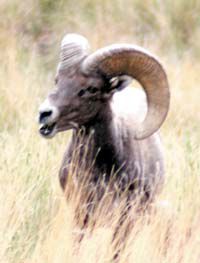| Bighorn sheep gather near the top of U.S. Highway 123 in Sunnyside. The bighorns migrate to this are every year and stay until early fall. |
On June 16, Utah Division of Wildlife Resources representative Brent Stettler hosted a bighorn sheep watch in Sunnyside’s Whitmore Canyon near the top of U.S. Highway 123.
According to Stettler, the local herd numbers 26 rams and five ewes.
“As in years past, the sheep spend the day feeding and lounging around the fire station and surrounding area. They water at Grassy Trail Creek or at a supplemental water trough. This particular group of bighorns is accustomed to vehicle traffic and human presence, and can often be observed and photographed at close distances,” commented Stettler.
The DWR representative reported that 2007 is the first year the typically all male band has traveled to the area with females. He estimated that the group could have picked the ewes up from another herd.
The bighorn sheep has tan or brown fur with a white belly, rump and muzzle. It is best known for its large horns.
The rams or males have large thick curving horns. The ewes or females have more slender horns that are less curved.
The bighorn is a good climber and jumper. The species is equipped with hooves that are hard around the outside and soft within for traction on slippery surfaces.
The bighorn can be found in the Rocky Mountains from southern Canada to Colorado and parts of Nevada, western Texas and eastern California and northern Mexico, along with Carbon County.
The large animal changes its home seasonally. In warm months, it grazes on mountain slopes and in colder months it moves down into the valleys.
In the fall males have head butting contests to establish dominance. They run at each other at speeds of up to 20 miles and hour and ram their heads together.
According to Stettler this ritual takes place for the Sunnyside herd when the rams return to their winter quarters in an area along the Green River.
Rams usually only fight with rams who have horns that are about the same size as their own. Head butting contests have been documented to go on for as long as 20 hours according to nature website natureworks.com.
Like with many wild animals the bighorn sheep display an interesting mating ritual.
Upon achieving dominance and when a male is ready to mate, he will go into a herd of females. The female is then required to chase him before he will mate with her. At times the male will kick a female to get her to chase him and begin the courtship ritual.
Females deliver young on cliffs that are difficult to access. They have only one offspring at a time.
The offspring is typically woolly white with little horns.
According to the website, the bighorn can walk and climb by the end of their first day of life. They stay hidden within their mountain lair for about a week until they start to follow their mother. The young will be weaned from its mother at about five months.
The bovine animals prefer to live in alpine meadows, mountain slopes and foothills. They graze on grasses, clover and sedges in the warm months and in colder months they will resort to eating woody plants like willow and sage.
The sheep use rocky slopes for quick climbing to avoid predators.
However, when a group of bighorns are threatened by a predator such as a wolf at times they will group together in a circle and face out toward the predator as one.
“If you missed the event on June 16 don’t worry,” concluded Stettler. “These sheep stay in the same general area until early fall and they come down near Highway 123 almost everyday.”
Information for this article was obtained through the local DWR and natureworks.com.

